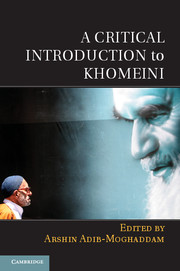Book contents
- Frontmatter
- Contents
- List of Map and Figures
- About the Authors
- Acknowledgments
- Glossary
- Timeline: The Life of Ayatollah Ruhollah Khomeini (1902–1989)
- Introduction Ayatollah Ruhollah Khomeini: A Clerical Revolutionary?
- 1 Khomeini and the “White Revolution”
- 2 The Rise of Khomeinism
- 3 Wilayat al-Faqih and the Meaning of Islamic Government
- 4 Ayatollah Khomeini’s Rule of the Guardian Jurist
- 5 Khatt-e Imam
- 6 Khomeini and the West
- 7 Gendered Khomeini
- 8 Hidden Khomeini
- 9 The Divine, the People, and the Faqih
- 10 Khomeini’s Legacy on Women’s Rights and Roles in the Islamic Republic of Iran
- 11 To Rule, or Not to Rule? An Alternative Look at the Political Life of Ayatollah Khomeini between 1960 and 1980
- 12 Khomeini and the Decolonization of the Political
- 13 Contentious Legacies of the Ayatollah
- Further Reading
- Index
- References
3 - Wilayat al-Faqih and the Meaning of Islamic Government
Published online by Cambridge University Press: 05 June 2014
- Frontmatter
- Contents
- List of Map and Figures
- About the Authors
- Acknowledgments
- Glossary
- Timeline: The Life of Ayatollah Ruhollah Khomeini (1902–1989)
- Introduction Ayatollah Ruhollah Khomeini: A Clerical Revolutionary?
- 1 Khomeini and the “White Revolution”
- 2 The Rise of Khomeinism
- 3 Wilayat al-Faqih and the Meaning of Islamic Government
- 4 Ayatollah Khomeini’s Rule of the Guardian Jurist
- 5 Khatt-e Imam
- 6 Khomeini and the West
- 7 Gendered Khomeini
- 8 Hidden Khomeini
- 9 The Divine, the People, and the Faqih
- 10 Khomeini’s Legacy on Women’s Rights and Roles in the Islamic Republic of Iran
- 11 To Rule, or Not to Rule? An Alternative Look at the Political Life of Ayatollah Khomeini between 1960 and 1980
- 12 Khomeini and the Decolonization of the Political
- 13 Contentious Legacies of the Ayatollah
- Further Reading
- Index
- References
Summary
Introduction
The triumph of the Islamic revolution of Iran in February1979 surprised many observers, and continues to baffle others today. The introduction into contemporary politics of a religious dimension challenged contemporary understandings of the human condition in ways that have called into question much of the basic premises of modern secularism. The revolution tended to be perceived largely in light of the preconceptions and predispositions of the observer rather than as something original and unique – sui generis. Many failed to see the revolution as a phenomenon that is to be understood and comprehended from within its own dynamics and on its own terms, rather than in terms of mere Western social science categories (insightful as they may be). Consequently, varied designations were and continue to be attributed to the Iranian state; ranging from it being a form of “anachronistic theocracy” to being pejoratively referred to as the “rule of the mullahs” or a “religious dictatorship”.
Such attitudes oversimplify highly complex issues and reflect an ideological prejudice and/or lack of comprehension. The deep impact that this revolutionary phenomenon had and continues to have on the Muslim community, both Sunni and Shi’i, renders it a profound social, political as well as religious innovation that combines the twin elements of religious reasoning (ijtihad) and renewal (tajdid). Both elements were infused with the praxis dimension, beyond mere theoretical constructs, through the theory of Wilayat al-Faqih and the person of al-Faqih represented by Grand Ayatollah Khomeini.
- Type
- Chapter
- Information
- A Critical Introduction to Khomeini , pp. 69 - 87Publisher: Cambridge University PressPrint publication year: 2014
References
- 5
- Cited by

